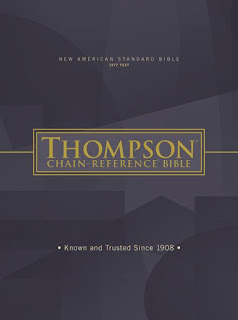 |
| Thompson Chain Reference Bible |
Full disclosure, I do not normally use a physical Bible any longer in my study. I use Logos Bible Software for hours every day. I study in a file I create in Microsoft Word that has the text of the book I am studying next to that book in the original language in a table. Along with that I have Logos open with the resources I use regularly, displayed with the Word document utilizing three monitors. The English version in the Word document is NASB. That said, I use a physical Bible when I am speaking to a group and when I am traveling overseas. Those are two different versions of the NASB. So, I am very familiar with the NASB, it is my go to version. Therefore, I was very pleased to be given the opportunity to review this iteration of the Thompson Chain.
As I have mentioned in previous reviews of the Quest Study Bible, the NIV Study Bible, the Verse Mapping Bible and Journal, and the NASB Adventure Bible, I highly recommend that you read the introduction and prefaces to any Bible Version you are contemplating. I will not rehearse the reasons already stated in the other reviews, but will say that for the NASB Thompson Chain, this moves from highly recommended to absolutely critical. I will go so far as to say that you will be lost or confused by the layout of the Bible if you should choose to skip those introductions and prefaces. There are too many features in the Thompson Chain to adequately and succinctly explain their use in a review such as this. However, as with my other reviews I will attempt to outline the usefulness of this Bible.
 |
| Figure 1 |
First, the Thompson Chain is a stealth study Bible. Stealth in that the vast majority of the study tools are in the back of the book on pages 1613 – 2238. You read that right, there are 625 pages of “Comprehensive Bible Helps” starting on page 1613. That is 28% of the publication. I am pleased that those helps are in the book, especially that they are in the back. That arrangement does not distract from the text of the Bible. Each page of the Bible is mostly Bible rather than notes. That allow one to study with less distractions. Figure 1 is the Index on page 1614 of the Bible (if you click on the picture you will get a larger image). A casual glance through that index reveals a wealth of material. Note especially the second entry, “Principles of Bible Study”. One of the benefits of the Thompson Chain is that it supports and encourages personal engagement in study this is the second article in the Book on Bible Study, the first is in the prefaces on page xii – xiii.
 |
| Figure 2 |
Finally I would draw your attention to the notes to the left of the beginning of the epistle. Notice that when a topic is mentioned in the text in the left or right center column, for example, Paul’s apostleship, you will find a similar notation in the left or right outside column like, “202 Paul’s Apostleship”. These follow the same format as mentioned above concerning “2697 Writer, Paul.” Again, these “pilot numbers” refer to the chains in the back of the book. These chains are what gives the Thompson Chain Reference Bible its name. There are about 100,000 references in the chains. Note that under the “202” reference there is noted “p.p. John 3:16 .” This is a reference that is a parallel passage and is independent of the chains.
.” This is a reference that is a parallel passage and is independent of the chains.
I find this system very good for a reference Bible. The reason is what I stated above. The notes, diagrams, and introductions to the different books do not distract from the text.
The not so good
If you will look again at figure 1 or 2, you will note that you can see and possibly read what was printed on the previous page. This is because the paper on which this book is printed is exceptionally thin. You will notice in figure 1 that I wrote in the page number on page 1614, you can plainly see where I wrote 1613 on the other side of the page. It did not bleed through, nor did a highlighter I tested; however, I use archival quality pens and highlighters. While it did not bleed through, it is certainly noticeable and would possibly make reading the next page somewhat difficult.
That would seem to suggest that this Bible will not travel well. Its best use would be a reference in your study. I would certainly test any pen or highlighter on one of the blank pages or in a margin that is clear before using them on this book.
Conclusion
If you are looking for a good reference to expand your Bible Study, this would be a good selection. You can get this book from BibleGateway here or from Amazon here. If you choose to purchase this from Amazon, Entrusting Truth will receive a small part of your purchase as a donation from Amazon.





















